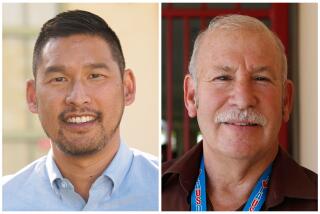Glendale and Burbank Pin Hopes on School Bonds
- Share via
The last time Glendale residents voted on a school bond issue, Lyndon Johnson was president and the Beatles were new to America.
In Burbank, officials say the last successful school bond vote came even earlier, while Ike was in the White House.
Now schools in both cities, representative of a statewide problem, are in desperate need of major repairs inside and out. Deteriorating plumbing, heating, electrical and lighting systems are plaguing schools, along with small classrooms ill-equipped for modern uses.
“You name it,” said Vic Pallos, a spokesman for the Glendale Unified School District. “Every school needs something.”
For that reason, Glendale Schools Supt. James R. Brown on Tuesday proposed a $162-million bond to fix the system’s aging buildings. Likewise, in Burbank, school officials will ask voters in April to approve $112.5 million to rebuild two high schools and make other repairs systemwide.
Officials say they are confident the time is right. The local economy is picking up, as is public awareness of the problems.
“Local school districts do need to approach their local communities,” said Sue Pendleton, a consultant with the state Department of Education’s school facilities planning division. “So many of our schools are very, very old. So just by virtue of being old, they need a lot of work.”
Pendleton said districts across the state are trying to raise money in the same way as Glendale and Burbank.
*
Still, school authorities and supporters are painfully aware of how tough it can be to obtain the required bond approval from two-thirds of the voters, or 66.7%, in their cities.
Just last November, the Los Angeles Unified School District’s $2.4-billion repair and construction bond measure failed despite receiving more than 65% of the vote.
Less than three years ago, a $100-million bond initiative to renovate schools in Burbank fell short when only 53% of the city’s electorate voted favorably.
At that time, Glendale officials pulled back on their own plans for a multimillion-dollar school bond, citing a struggling economy and anti-tax sentiment.
These days, with schools that date to the 1920s, Glendale officials say the need is urgent.
“Our facilities in this district are simply wearing out,” said Brown, whose district has about 30,000 students in kindergarten through grade 12. “The clock’s run out.”
Schools Supt. David Aponik said the same is true in neighboring Burbank, where there are about 14,000 students.
“At some schools it’s more obvious than others,” Aponik said. “It’s really the infrastructure and the accommodation of growth.”
Indeed, one clear challenge is making sure voters realize that in many cases the most severe problems are hidden inside the school’s walls, officials said.
At Toll Middle School in Glendale, for instance, Principal Gloria Vasquez can walk proudly through old but polished hallways while also longing for more than one electrical outlet in every classroom.
“More juice,” as Vasquez puts it, is but one item on her long list of “specific needs” for the school. Others include an automatic rather than manual alarm system, new windows to replace rotting ones, air conditioning, a general overhaul of classrooms, an auditorium to meet modern standards and a public address system.
Vasquez said movie companies have checked out the school as a site for filming scenes from the past. The school auditorium, she said, has its original wooden seats and ancient, protruding floor vents for heat.
“We’ve got 70 years of scratching off people’s names,” Vasquez said with a chuckle, passing her hand along a wooden seat back.
The three-story stucco school, like many others, has exposed pipes covered with insulation and ragged tape that’s been painted over to make it look neater. Evidence of patchwork maintenance is everywhere.
Even so, several students--who described toilets that do not flush properly, loose ceiling tiles and unbearable heat on some days--said the conditions do not bother them too much.
“It doesn’t matter to me,” said Jeff Lee, 14, an eighth-grader. “School is school.”
But Mary Carter, also 14 and in eighth grade, said hot days do get uncomfortable. Also, a public address system would be useful, she said.
“Some teachers don’t read the bulletin and we don’t know what’s going on,” she said. “I think they think it takes up class time.”
*
Vasquez said she hopes public reaction will not be dominated by voters who view conditions as being as good or better than when they were in school.
“The truth is that in today’s world, we’re trying to prepare kids for the 21st century,” she said.
Brown said the bond proposal in Glendale could grow to as much as $200 million if the school board decides to take his recommendation to rebuild two elementary schools and build an addition to Crescenta Valley High School.
The bond, if approved, would probably result in homeowners paying about $50 to $60 per $100,000 of assessed valuation each year for at least 10 or 15 years, officials said.
The school board must decide on the amount by the end of January for the measure to appear on the June 3 ballot.
In Burbank, Aponik said the proposed bond financing would include about $81 million for extensive work at Burbank and Burroughs high schools.
For several years, conditions at the schools have left students wearing coats when it was cold or perspiring when it was hot. Lighting has been poor and electrical power failures have been common.
“It continues that way,” Aponik said.
Besides improving the high schools, bond funds would help add classroom space and bring general upgrades at all of the district’s 19 sites, many of which are more than 60 years old, he said.
For Burbank taxpayers, the bond financing would cost an average of $45 per $100,000 of assessed valuation of their homes annually for 25 years, he said.
Last month, Burbank school officials established a long-term maintenance fund of at least $4 million per year to keep the schools from deteriorating again.
Richard Raad, who co-chairs a volunteer group called Friends for Burbank Schools, said he is convinced local residents will agree the school-bond initiative is a worthwhile investment.
“We think the educational process is wonderful,” said Raad, whose daughter, Jennifer, is a senior at Burroughs High, and son, Richie, is in kindergarten at Emerson Elementary School. “We could enhance the learning process.”
Said Glendale’s Brown: “This investment has a high payoff.”
More to Read
Sign up for Essential California
The most important California stories and recommendations in your inbox every morning.
You may occasionally receive promotional content from the Los Angeles Times.










